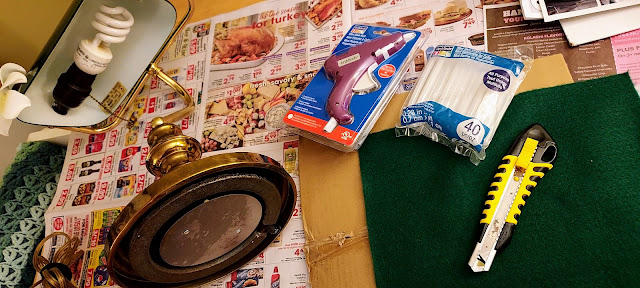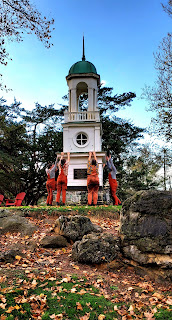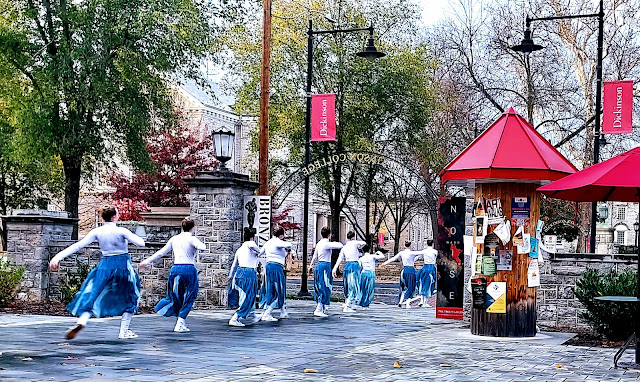Welcome to my Album of Photographs and Memories of Travel, practicing Medicine, culinary Experiments, and other Exploits.
Sunday, November 20, 2022
Thrifty & Crafty
Thursday, November 17, 2022
"Cholera and Fear" / "Die Cholera und die Furcht"
"'Tis the season," said one of my colleagues, to explain the sudden influx in gifts from patients in a single morning clinic session. One woman who "stress bakes" brought her provider a veritable pyramid of goodies. Others picked up pre-packaged chocolates: foil-covered milk-chocolate balls, Ghirardelli squares, locally famous Sarris chocolate-covered pretzels. You can see that by the end of the day, we had made significant in-roads.
„Die Cholera und die Furcht.“ Von Hermann Friedrichs.
Die einst Welt und Geist geknechtet hat,
Pocht ein Fremdling mit dem Schwertesknauf:
Und des Wächters helle Augen schaun
Forschend in des Pilgers Angesicht:
,,Deiner Stimme, Fremdling, trau‘ ich nicht!
Diese Stadt hat Gott mir anvertraut!“
,,Gott ja sendet mich!“ ruft Jener wild.
,,Komm und prüfe meinen Wappenschild,
Hab‘ vor kurzem erst ihn aufgefrischt,
Wo der Nildunst mit dem Smum sich mischt—
Emsig mäht mein Schwert, wenn ich es schwinge,
Leistet du mir nicht den heil’gen Schwur,
Mir zu nehmen tausend Seelen nur.
Denn ich weiβ, du bist ein Nimmersatt,
Schafft gern mehr, als Gott geboten hat.“
Jener schwört. Der Pförtner läβt ihn ein.
Düster schleicht ein Schatten hinterdrein—
Eine Alte, bleich und abgezehrt,
Mit des Allgewalt’gen Schild beschwert.
Fragend miβt der Pförtner die Gestalt,
Doch ihr Blick durchzuckt ihn meh und kalt—
,,Gott, erbarme dich der tausend Seelen!“
Spricht er schauernd, ,,laβ sie dir empfehlen!“
Wochen flohn—Die Stadt füllt Schreckt und
Graus.
Nach den Bürgern, die der Stadt entfliehen.
Heiβ durchwühlt die Adern ihm der Zorn,
Immer neue Bahren ziehn vorbei,
Immer lauter hallt das Wehgeschrei.
Ach! schon fünfmal tausend liegen todt,
Und noch immer mehrt sich Leid und Noth.
Endlich kehrt der Gottgesandte wieder,
Und du brachst den Eid?“
Was darüber, nahm dir diese da,
Stets, auf Schritt und Tritt, war sie mir nah—”
,,Und wer ist dies Scheufel?“
,,Blicke hin,
‘s ist die Furcht, die schlimmste Würgerin!“
~ * ~ * ~ * ~ * ~ * ~ * ~ * ~ * ~ * ~ * ~ * ~ * ~ * ~ * ~ * ~ * ~ * ~ * ~ * ~ * ~ * ~ * ~ * ~ * ~
“Cholera and Fear.” By Hermann Friedrichs.
with the pommel of his sword. “Hollah, porter, unbar the gate for me!”
The shout boomed gruesomely through the night, and the guard’s bright eyes looked searchingly at the pilgrim’s countenance: “I do not trust your voice, stranger! Wait outside until the morning dawns—God has entrusted me with this city!”
“It is God who sends me!” replied the other roughly. “Come and examine my escutcheon [crest]. I’ve just cleaned it where the Nile miasma and desert sandstorm mingle. My sword reaps assiduously when I swing it, [for] the heat of fever hardens its blade.”
The porter blanched at the horror: “Nevertheless,” he said, “I will defend my territory against you, if you do not render me the holy oath, that you will only take a thousand souls. Because I know that you are a glutton who likes to do more than God has allowed.”
Citation: Hermann Friedrichs, “Die Cholera und die Furcht,” Die Gegenwart 26 (1884): 86.
Miasmata, citizens
fleeing in panic, a plague sent from God, a moral punch line warning of the
evil of fear itself—surely these are not imagery one would associate with a
modern, industrial, scientifically-advanced country. And yet, this poem was
written not when Europe first encountered cholera in the politically restive
early 1830s,
nor in 1848 when revolution also broke out (again), nor even during repeat
epidemics in 1853-55 or in 1866-75. “Cholera and
Fear” appeared in the weekly family magazine Die Gegenwart in 1884. From Calcutta (now Kolkata), Dr. Robert Koch
(1843-1910) had just announced that he had identified the cause: Vibrio
cholerae. Coming so soon after his identification of Bacillus anthracis in
1896 and Mycobacterium tuberculosis in 1882, it was yet another triumph
for himself and the German state that financed his research in Germany, Egypt,
and India.
Tuesday, November 8, 2022
Daytripping, part 2 of 2
Monday, November 7, 2022
Daytripping, part 1 of 2
One of my college buddies was in the Philadelphia area for her cousin's wedding and offered to meet me halfway, so I jumped on the chance for a weekend daytrip. A hamlet called Burnt Cabins is exactly halfway between Pittsburgh and Allentown, but the only thing there is an old grain mill, so I decided to go all the way to Carlisle, just half an hour from where they could pick me up at the train station in Harrisburg. Home of Dickinson College and not far from the beautiful Appalachian scenery of King's Gap, Carlisle (pop. 20K) is perhaps more infamous for having been the site of the first Indian Boarding School, where thousands of Native children were forcibly Americanized, and hundreds died.



































